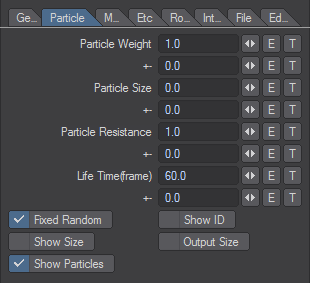Particle Tab
On the Particle Tab, you set parameters that describe the created particles.
- Particle weight - sets an arbitrary weighting value that will influence how properties like gravity affect the particles.
- Particle size - affects the outer boundary used for collision detection. It can also be used by volumetric plug-ins like HyperVoxels.
- Particle resistance - adds an air resistance effect. Particles will move slower as you increase this value.
- Life time (frame) - sets the life of the particles in frames. Once a particle is born, it lasts only this long.If you activate Fixed Random, random calculations are constant, so they yield more predictable results. (Setting Life time to 0 means the particle will not die or age)
- Fixed Random - Is for the generation of particles. In most cases this should be left on.
- Show ID - By activating the Show Id option, each particle will display a number in the Layout viewport indicating the index number of the particle.
- Show Size - The Show Size option draws a wireframe sphere around each particle representing the particle’s current size.
- Output Size - If the Output Size is not checked, the size will always be 1.
- Show Particles - The display of particles in OpenGL windows.
The plus(+) and minus(-) fields randomize the preceding field by adding or subtracting a value between 0 and the number entered. So if Particle weight was 1 and its randomize value was .1, the Particle weights would range from .9 to 1.1. A total particle value of zero or less will be zero.
